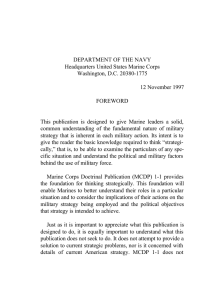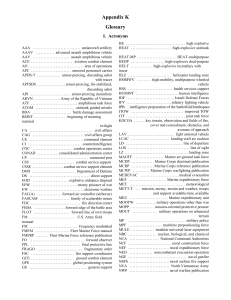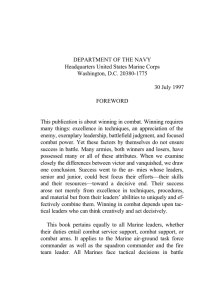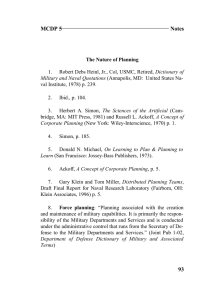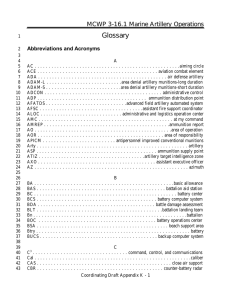MCDP 3 Notes The Landscape: Chaos in the Littorals
advertisement
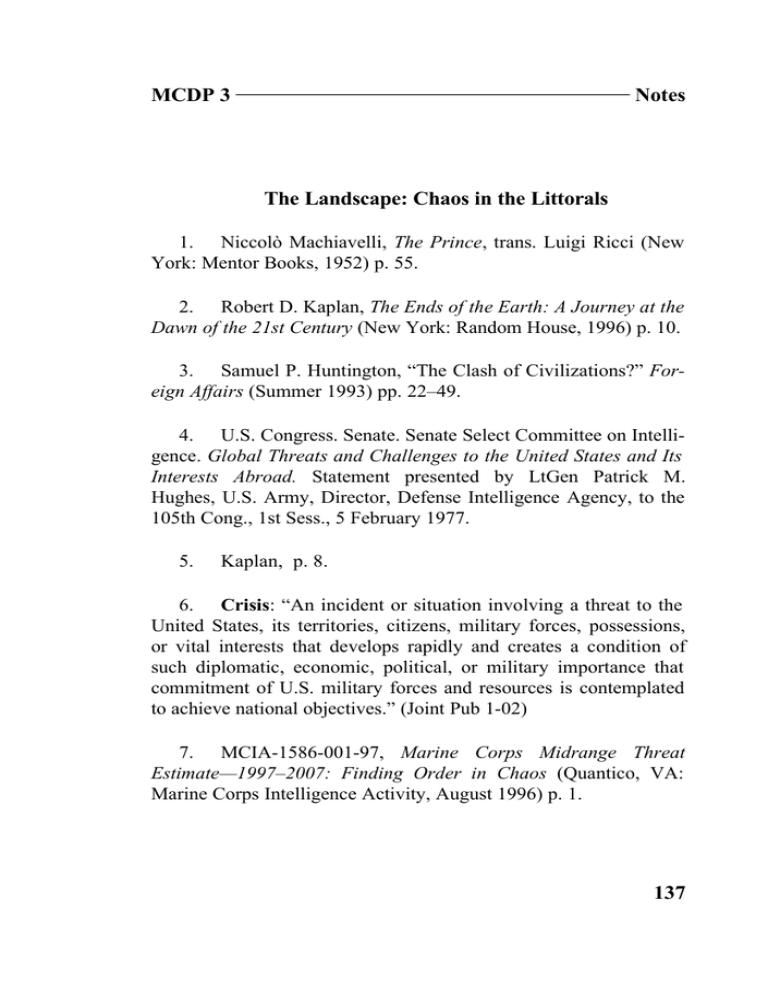
MCDP 3 Notes The Landscape: Chaos in the Littorals 1. Niccolò Machiavelli, The Prince, trans. Luigi Ricci (New York: Mentor Books, 1952) p. 55. 2. Robert D. Kaplan, The Ends of the Earth: A Journey at the Dawn of the 21st Century (New York: Random House, 1996) p. 10. 3. Samuel P. Huntington, “The Clash of Civilizations?” Foreign Affairs (Summer 1993) pp. 22–49. 4. U.S. Congress. Senate. Senate Select Committee on Intelligence. Global Threats and Challenges to the United States and Its Interests Abroad. Statement presented by LtGen Patrick M. Hughes, U.S. Army, Director, Defense Intelligence Agency, to the 105th Cong., 1st Sess., 5 February 1977. 5. Kaplan, p. 8. 6. Crisis: “An incident or situation involving a threat to the United States, its territories, citizens, military forces, possessions, or vital interests that develops rapidly and creates a condition of such diplomatic, economic, political, or military importance that commitment of U.S. military forces and resources is contemplated to achieve national objectives.” (Joint Pub 1-02) 7. MCIA-1586-001-97, Marine Corps Midrange Threat Estimate—1997–2007: Finding Order in Chaos (Quantico, VA: Marine Corps Intelligence Activity, August 1996) p. 1. 137 Expeditionary Operations MCDP 3 8. Dr. James N. Rosenau, “Fragmegrative Challenges to National Security,” in Understanding U.S. Strategy: A Reader, ed. Terry L. Heyns (Washington, D.C.: National Defense University Press, 1983) pp. 65–82. 9. MCIA-1586-001-97, p. 11. 10. Ibid., pp. 14–15 and 42–43. 11. Charles William Maynes, “Relearning Intervention,” Foreign Policy (Spring 1995) p. 108. 12. MCIA-1586-001-97, p. 2. 13. Ibid. 14. Ibid. 15. Ibid., p. 3. 16. World Resources 1996–97 (New York: Oxford University Press, 1996) p. ix. 17. MCIA-1586-001-97, p. 8. 18. World Resources 1996–97, pp. 58–59. 19. Ibid., p. 9. 20. Eric Grove, The Future of Sea Power (London: Routledge, 1990) p. 31. 138 MCDP 3 Notes 21. Ibid., p. 46. 22. MCIA-1586-001-97, pp. 1 and 3. 23. World Resources 1996–97, pp. 60–61. 24. The five permanent members of the United Nations Security Council—the United States, Russia, the United Kingdom, France, and the People’s Republic of China—are all declared nuclear powers. India, Pakistan, and Israel are known to possess nuclear weapons. North Korea and Iraq have had confirmed nuclear weapons production programs, and Iran is suspected of conducting nuclear weapons research. Politicians in Taiwan have expressed an interest in developing nuclear weapons, and South Korea had official plans to develop nuclear weapons as late as 1991. South Africa, Argentina, and Brazil have all renounced their nuclear weapons programs but have the technological capability to resume them at any time. Essentially any group with a technological capability equivalent to that of the United States in the 1960s could design a nuclear weapon. MCIA-1586-001-97, p. 15. The Nature of Expeditionary Operations 1. Sir Julian Corbett, Some Principles of Maritime Strategy (Annapolis, MD: Naval Institute Press, 1988) p. 16. 2. Lowell Thomas, Old Gimlet Eye: The Adventures of Smedley D. Butler (New York: Farrar & Rinehart, 1933) p. 127. 139 Expeditionary Operations MCDP 3 3. U.S. President. A National Security Strategy for a New Century (Washington, D.C.: The White House, Office of the President of the United States, May 1997) pp. 14–15. 4. Expedition: “A military operation conducted by an armed force to accomplish a specific objective in a foreign country.” (Joint Pub 1-02) 5. Force: “1. An aggregation of military personnel, weapon systems, vehicles, and necessary support, or combination thereof.” (Joint Pub 1-02) 6. Logistics: “The science of planning and carrying out the movement and maintenance of forces.” (Joint Pub 1-02) 7. F. G. Hoffman, “Advanced Expeditionary Warfare–2015” (unpublished draft concept paper, Marine Corps Combat Development Command, Studies and Analysis Division, Quantico, VA, 1996). 8. The Marine Corps no longer employs the Marine expeditionary brigade organization. A Marine expeditionary brigade was roughly one-third the size of a Marine expeditionary force and comprised a permanent command element and units from one of the standing Marine expeditionary forces. These brigade command elements are no longer in existence. 9. Robert Debs Heinl, Jr., Col, USMC, Retired, Dictionary of Military and Naval Quotations (Annapolis, MD: United States Naval Institute, 1966) p. 11. 140 MCDP 3 Notes 10. This responsibility is assigned to the Marine Corps by United States Code, Title 10, chapter 503, section 5013, with the following words: “The Marine Corps shall develop, in coordination with the Army and the Air Force, those phases of amphibious operations that pertain to the tactics, techniques, and equipment used by landing forces.” 11. Strategic mobility: “The capability to deploy and sustain military forces worldwide in support of national strategy.” (Joint Pub 1-02) 12. Sustainability: “The ability to maintain the necessary level and duration of operational activity to achieve military objectives. Sustainability is a function of providing for and maintaining those levels of ready forces, materiel, and consumables necessary to support military effort.” (Joint Pub 1-02) Expeditionary Organizations 1. Quoted in Robert D. Heinl, Jr., Col, USMC, Retired, The Marine Officer’s Guide (Annapolis, MD: Naval Institute Press, 1977) p. 71. 2. Quoted in Robert D. Heinl, Jr., Col., USMC, Retired, Victory at High Tide: The Inchon-Seoul Campaign (Baltimore, MD: The Nautical & Aviation Publishing Company of America, 1979) pp. 6–7. 3. Expeditionary force: “An armed force organized to accomplish a specific objective in a foreign country.” (Joint Pub 1-02) 141 Expeditionary Operations MCDP 3 4. Landing force: “A task organization of troop units, aviation and ground, assigned to an amphibious assault. It is the highest troop echelon in the amphibious operation.” (Joint Pub 1-02) 5. “Department of the Navy 1997 Posture Statement,” Marine Corps Gazette (April 1997) p. 14, excerpt from a report by the Honorable John H. Dalton, Adm Jay L. Johnson, and Gen Charles C. Krulak. 6. Fleet Marine Force: “A balanced force of combined arms comprising land, air, and service elements of the U.S. Marine Corps. A Fleet Marine Force is an integral part of a U.S. Fleet and has the status of a type command.” (Joint Pub 1-02) 7. The force that conducted Operation Eastern Exit was at the time called a “contingency MAGTF,” a term no longer in use. 8. Service component command: “A command consisting of the Service component commander and all those Service forces, such as individuals, units, detachments, organizations, and installations under the command, including the support forces, that have been assigned to a combatant command, or further assigned to a subordinate unified command or joint task force.” (Joint Pub 1-02) 9. Functional component command: “A command normally, but not necessarily, composed of forces of two or more Military Departments which may be established across the range of military operations to perform particular operational missions that may be of short duration or may extend over a period of time.” (Joint Pub 1-02) 142 MCDP 3 Notes Expeditionary Concepts 1. Quoted in Heinl, Victory at High Tide, p. xv. 2. Quoted in Assault From the Sea: Essays on the History of Amphibious Warfare, ed. Merrill L. Bartlett, LtCol USMC, Retired (Annapolis, MD: United States Naval Institute, 1983) p. xi. 3. Operational Maneuver from the Sea, (Quantico, VA: Marine Corps Combat Development Command, Concepts Division, 1996) PCN 145 000001 00. 4. Amphibious operation: “An attack launched from the sea by naval and landing forces embarked in ships or craft involving a landing on a hostile or potentially hostile shore.” (Joint Pub 1-02) 5. For the history of Operation Forager, see Henry I. Shaw, Bernard C. Nalty, and Edwin T. Turnbladh, Central Pacific Drive, History of U.S. Marine Corps Operations in World War II, vol. III (Washington, D.C.: Headquarters, U. S. Marine Corps, Historical Branch, 1966) pp. 231–585; Jeter A. Isely and Philip A. Crowl, The U.S. Marines and Amphibious War: Its Theory, and Its Practice in the Pacific (Princeton, NJ: Princeton University Press, 1951) pp. 320–371; and FMFRP 12-109, The Amphibians Came to Conquer: The Story of Admiral Richmond Kelly Turner, vol II (September, 1991) pp. 853–968. 6. This case study is taken primarily from Col Charles J. Quilter, U.S. Marines in the Persian Gulf, 1990–1991: With the I Marine Expeditionary Force in Desert Shield and Desert Storm (Washington, D.C.: Headquarters, U.S. Marine Corps, History and 143 Expeditionary Operations MCDP 3 Museums Division, 1993). See also J. Robert Moskin, The U.S. Marine Corps Story (Boston: Little, Brown and Co., 1992). 7. Quilter, pp. 73–74. 8. Ibid., p. 76. 9 Ibid., p. 102. 10. Military operations other than war: “Operations that encompass the use of military capabilities across the range of military operations short of war. These military actions can be applied to complement any combination of the other instruments of national power and occur before, during, and after war.” (Joint Pub 1-02). According to Joint Pub 3-07, Joint Doctrine for Military Operations Other Than War (June 1995), the 16 types of military operations other than war are: arms control, combatting terrorism, DOD support to counterdrug operations, enforcement of sanctions/maritime intercept operations, enforcing exclusion zones, ensuring freedom of navigation and overflight, humanitarian assistance, military support to civil authorities, nation assistance/support to counterinsurgency, noncombatant evacuation operations, peace operations, protection of shipping, recovery operations, show of force operations, strikes and raids, and support to insurgency. This listing of military operations other than war is somewhat misleading in that many of the operations included in this category, for example strikes and raids, clearly fall within the classical definition of war. 11. The definitive treatment of Operation Eastern Exit is Adam B. Siegel, Eastern Exit: The Noncombatant Evacuation 144 MCDP 3 Notes Operation (NEO) from Mogadishu, Somalia, in January 1991 (Alexandria, VA: Center for Naval Analysis, 1991). See also Adam B. Siegel, “Lessons Learned From Operation EASTERN EXIT,” Marine Corps Gazette, June 1992, pp. 75–81. 12. Siegel, “Lessons From Operation EASTERN EXIT,” June 1992, p. 77. 13. FMFM 5-1, Maritime Prepositioning Force Operations (October 1993) p. 1-1. 14. This case study is taken primarily from Quilter. Operation Littoral Chaos 1. Martin van Creveld, The Transformation of War (New York: The Free Press, 1991) p. 2. 145



